Welcome to the metaverse
It was in October 2021 that Facebook, Inc (NASDAQ: FB) announced it would change its name to that of Meta Platforms (NASDAQ: META),
Under Mark Zuckerberg’s directive the FAANG member sought to strengthen its association with a term which already for quite a while has belonged to the particular vision of Facebook’s founder.
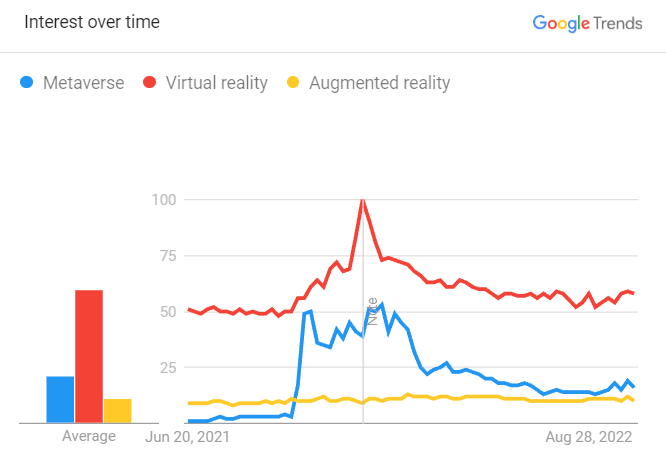

In origin, the so-called “metaverse” is a science fiction and futurology concept describing a virtual environment where people interact in a similar manner to that of the physical world, although it is not constrained by the realistic aesthetics or rules of the latter.
Metaverse examples can be found in literary works like the nineties classic Snow Crash or the more recent Ready Player One novels; the famous film saga Matrix also makes extensive use of the concept.
For Mark Zuckerberg the metaverse is poised to become the next natural stage of the Internet, an improved iteration where keyboards and screens give way to virtual reality glasses, headsets, controllers and where even orders are carried out just by pure thought.
It is unsurprising that Meta has opted for both the promotion and development of this broad idea. In 2014 the company acquired VR headset designer Oculus for a combination of stock and cash estimated at 2.3 billion dollars. Since then, Oculus has launched several devices which slowly but surely are becoming more prevalent among consumers.
Similarly, other divisions inside Meta are dedicated to developing technologies whose general aim is to turn the metaverse into reality.
According to a Statista report published by analyst Thomas Alsop, in 2022 the virtual reality market was valued at around 12 billion USD. The same analyst estimates that this sum will grow to around 25 billion by 2025.
International Data Group, currently owned by investment firm Blackstone, has reported under a subsidiary that VR equipment sales grew 241.6 % YoY during the first quarter of 2022, Meta being the dominant player in this segment by virtue of acquiring around 90% market share.
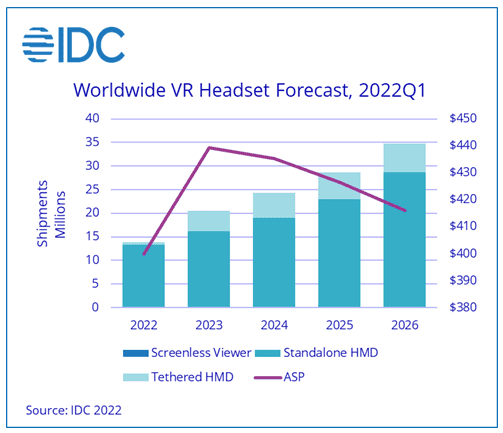

Influenced by its conceptual appeal, there are those that believe the metaverse will truly become the future of Internet interaction.
If augmented reality products such as Nintento’s Pokemon Go first revealed an inkling of the potential of these types of technologies, Zuckerberg and others within the same space have remarked on the productive possibilities that a more immersive experience could bring.
Under their vision the metaverse could become a collaborative environment without precedent; one where professional and leisure activities will normally take place. In it companies will hold meetings and conferences, surgeons will practice medical procedures, students will be able to visit ancient civilizations at the height of their might while huge cities brimming with people going about their daily lives will exist.
Additionally, exploring fantasy worlds or inhabiting movie ones will be possible if the environment is indeed programmed for such purposes.
In the present day one can already speculate with virtual real estate, and exchange-traded-funds that follow a basket of corporations related to the industry have been launched.
Eric Sheridan, a researcher at Goldman Sachs, revealed during one of the investment bank’s podcasts that in the future the metaverse is estimated to involve 8 trillion dollars in annual transactions.
It would have been interesting to find a more detailed description of how Goldman reached said number; the same way a revision is recommended considering the inflationary and recessive macroeconomic framework that one year later we find ourselves in. This observation stems from tech growth projections being optimistic during times where cheap credit is available.
Pessimism regarding the metaverse
On the opposite side of the aisle we find those that deem Zuckerberg’s metaverse either too buoyant or straight up vaporware.
Oddly enough, many that do not grant substance to the concept are those most versed in interacting with virtual simulation. Of course, the group I am referring to is gamers.
Even if I do not consider the metaverse a scam, I tend to sympathize with the skeptics. For the time being I consider the metaverse to be no more than a teleologically half-baked idea with no short amount of obstacles in its way.
At first glance the metaverse sounds appealing, but the probabilities of it becoming a common tool for work are slim in practice. Or at least in the short to mid-term.
The essence of my criticism is the following: the metaverse’s problem does not originate from an impossibility of designing the necessary technologies for it as much as it originates from the absence of incentives for its adoption at the scale Meta and the rest of companies in the industry expect it to; in other words, as the incremental and non-disruptive technology that it is, the metaverse will not replace conventional internet interaction technologies such as those of the mouse, screen and keyboard type.
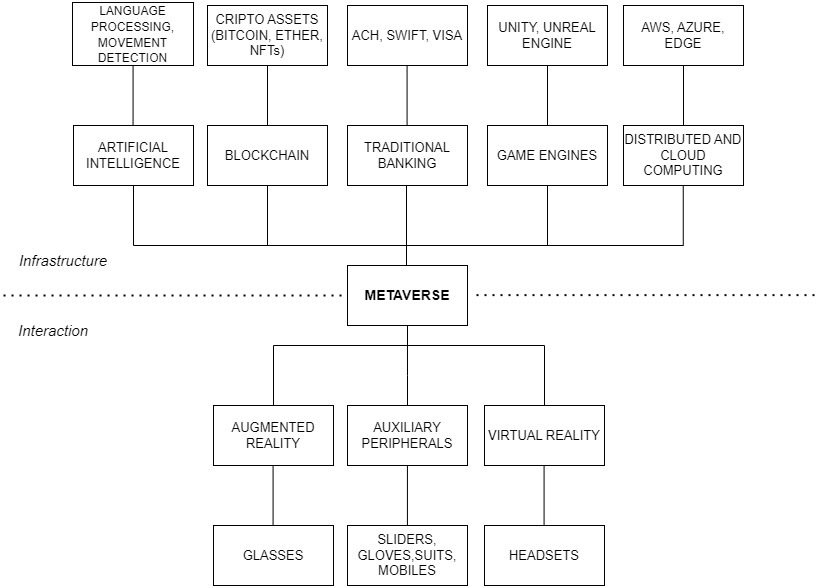

In this article we will not focus much on the technical handicaps. We will rather explain the issues that come from the interaction side.
The company holding the greatest market power and standardization protocols within the sector is clearly Meta. As such, we will not explore alternative metaverses which do not have neither the reach nor the concentration of talent of the old Facebook.
Let us explore the issues which will prevent the metaverse from turning into a giant revolution.
The VR headset and its productivity problems
Perhaps the most intuitive and visible problem of them all, as of right now the most widely accessible technology for interacting with the metaverse is the VR headset, a device that comes with a large internal display and a head strap for adjustment. This grants the user 360 degree immersion inside the rendered environment.
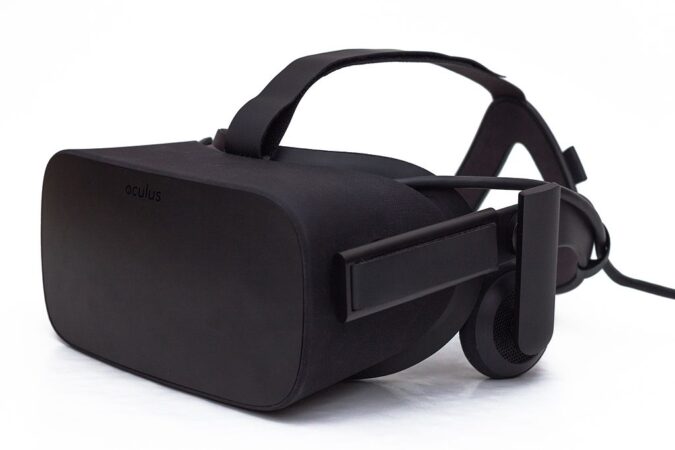

If the user does not require movement the headset by itself is enough, though it is commonly accompanied by a pair of hand controllers wrapped around the wrist; these come with directional wheels that enable in-simulation movement.
Having described the most basic tools for VR interaction, let us think about the next examples.
Imagine a meeting between a group of company managers or a class of students joining a remote lecture.
Assuming that all have to remain seated for the event, what exactly is the added value offered by the headset in comparison to a flat computer screen in a Zoom or a Skype call? Aside from the novelty factor, which can wear off pretty fast, does the 3D experience offer something so important as to require investment in VR inventory? Are meetings going to become more productive? Does having a 360 surround view in the middle of the meeting seem like a vital necessity? Or does it constitute, by contrast, an unnecessary distraction?
The clear answer is that a virtual reality meeting does not offer any tangible benefit; for the most important thing in any meeting that pretends to be serious is focusing on the content, which first comes by ear and later perhaps through the eyes if a slide or a whiteboard is needed.
The prospect of a virtual reunion loses even more credible appeal when taking into account the rather caricaturesque character interfaces these metaverses usually come equipped with (the graphics department is explored further below).
The issue of movement and the metaverse
The metaverse’s second issue comes from the maneuverability aspect most commonly performed via a controller’s directional wheel.
While three virtual dimensions easily adapt themselves to eyesight, muscles are not so easily deceived.
In fact, this is the aspect that reminds the base user of how limited interaction in virtual worlds is.
In real life, in order to move towards a certain direction all I have to do is walk by moving my legs; to move towards the same direction in a virtual environment I have to use my fingers.
Similarly, in order to manipulate any object I must pick it up using my opposable thumbs; to do the same thing with a controller I must either make a specified preprogrammed movement or point towards the object while pressing a button, something which is not comfortable.
Can gloves with precision sensors be designed?
Yes, they do exist.
Can you walk with a VR headset?
Usually you can, but the liberty of movement is constrained due to the often limited amount of space one handles these devices in.
What if you walk in a wide open space?
For starters, here one already assumes that the person has to go to one such place and that it has to be fairly empty. Furthermore, you still have to be aware of the real surroundings so you do not bump into another person or reach the walled limits of said space. This problem can be sorted out with proximity alert systems, though the main hurdle still stands: it is inconvenient.
Can a static system for movement be used?
Thus far, designing an omnidirectional treadmill has proven difficult. Nevertheless, there are companies which seek to improve this major weakness of VR that have already developed good solutions for it.
As the author of the video down below says himself, a better name for these so-called omnidirectional treadmills would be omnidirectional sliders.
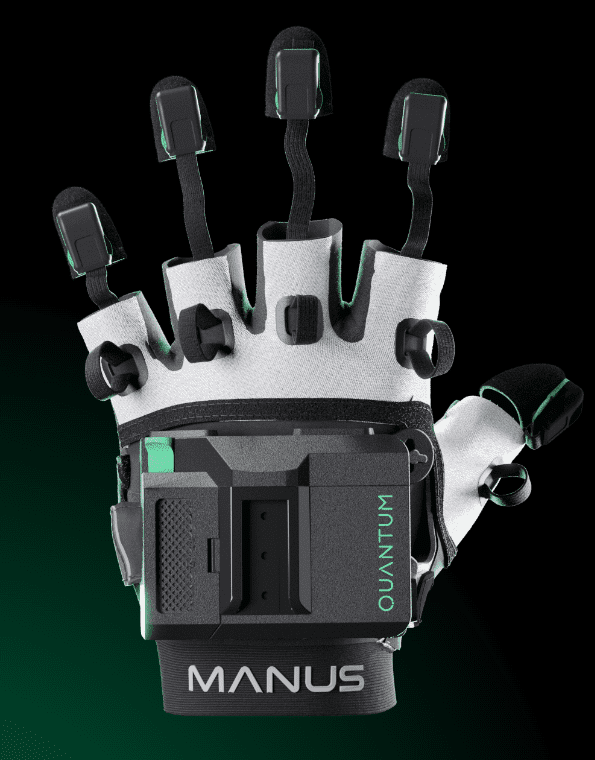

Despite the sliders being the most elegant product available, we must be reminded that the existence of a solution does not equal its use being common, either by a lack of demand or supply.
Quality and power do not determine efficiency
The supersonic Concorde jet remains the fastest commercial flight in History. Due to its high costs and low demand the jet was not profitable, and thus it was retired in 2003. Even those that could afford a ticket preferred paying less and spending more hours flying over the Atlantic.
Smartwatches are marvels of engineering that bring together a surprising array of functionalities inside a tiny device. Even so, their introduction has not brought forth major displacement of traditional watch and smartphone markets as the utility gained from them does not outweigh other aspects valued by consumers. Why would they use a smartwatch when their phones are already portable, easy to use and fulfill similar tasks? Why would traditional watch owners buy one when they can already afford phones?
Think of any e-book device; it is capable of storing entire libraries worth of literature, yet it has not rendered paper formats obsolete. Plenty of avid readers enjoy the feel of paper and the collection of physical copies for the sake of having them. Meanwhile, infrequent readers simply may derive more value from buying their book of choice from time to time rather than a Kindle.
When it comes to the second possibility, the absence of supply, one need not look further than the Soviet Union, whose scientific and technical achievements some people marvel at whilst forgetting its scarcity and the systematic lack of production and distribution capabilities that it had.
I may digress, but I believe it is important to emphasize that even a qualitatively superior product is not guaranteed to have greater adoption levels. Were we to grant the metaverse a claim to superiority, if it is not accessible or disruptive enough it will not have enough demand.
A similar thing happens with crypto assets, where obscure terminology and multiple layers among other things contribute to their lesser acceptance.
Deploying good solutions for the most demanding of VR users does not take away from the problem of having additional requirements for good interaction inside it.
An additional requirement is an additional hindrance, a barrier. And we would not be misdirected by interpreting that these auxiliary technologies are the tools of one who seeks entertainment in lieu of performing some professional activity.
Graphics and the promise of photorealism
Regarding the software that powers the metaverse itself, one of the most pressing issues when it comes to promoting productivity thus far is that it fails to provide a proper ecosystem for it. Something which Meta is thankfully aware of.
Observe the videos first used by Meta for promoting the technology.
(No need to manually pause the video)
For the sake of truth at 6:55 in the video Zuckerberg himself mentions that the metaverse will allow photorealistic models oriented towards work. It is rather odd then that in the productivity section of the video images like the following are shown.
In the metaverse video presentation we do find examples of digital photo realistic avatars, which grants some legitimacy to the idea of maintaining future work relations through there.
We can see how an accurate facial recognition system is being developed and how it can adapt to real time gestures. Although a prototype, the technology could perfectly become a general standard in the coming years.
I have, however, some reservations in relation to the topic of photorealism because outside of the resources needed for a face in a greater visual environment it requires advanced graphical chips (GPUs) such as those that are sold by Nvidia and to a lesser extent AMD. Oculus headsets currently demand either connection to an external PC for rendering or come with an integrated hybrid Qualcomm Snapdragon mobile chip.
Can Meta implement photorealism in head-adjusted devices with the expectations of Oculus maintaining acceptable temperature and weight levels? Or will photorealism just be accessible to users with a high-performance PC?
An alternative approach could be deploying graphics chips inside a remote warehouse, much like it is done with data centers and other forms of cloud computing. In recent years videogame streaming services have grown in popularity, requiring users to pay a monthly subscription so they can play demanding titles from a computer unequipped for it. For as long as latency is low it seems that these services can work well enough.
Regardless, photorealism does not determine the final success of the metaverse. It only makes it more visually faithful to reality. There are multiple other elements to take into account.
Tactile and auditory stimuli
In the metaverse presentation video Zuckerberg promotes activities like boxing, basketball, fencing or surfing as possible leisure for VR users.
Doing such activities in a virtual environment is quite different from doing them in real life.
When a person surfs he expects the friction of the board beneath the feet, the movement of the waves, the gusts of wind and the water of the sea hitting the entire body.
When it comes to boxing, basketball and more, one can indeed create a simulation for punching, lunging or passing a virtual ball. Mimicking the sensation received upon impact, not so much.
Pressure suits equipped with sensors that react in sync with the simulation can be designed (yet again, another requirement for something that can be done in real life for much cheaper).
These suits would still be unable to copy the exact sensation of being hit or having a ball between the hands.
It could be argued that there is no need for these suits or games to completely mirror the real thing. After all, video game players rarely complain about the limitations offered by a controller in a shooter or FIFA not allowing them to hit a real ball. Thus, for some users the metaverse could do the trick.
The example of Nintento’s Wii is the closest one to the metaverse’s own proposal relating to exercise.
An encouraging fact is Wii Sports being by far the most popular title sold for the Wii. No doubt, Meta could bank on VR offering a much richer experience in a market that already has shown demand for it.
The comparison is, in my opinion, somewhat misleading. Not only because the retail price of a console like the Wii is smaller than the required VR equipment, but because the act of playing a family sports videogame is notably different from doing an actual sport.
If exercising was the main priority for the VR buyer, the metaverse would be neither their first or second go-to choices. The person would exercise in a real setting, such as that of a gym or a field.
This notion of offering alternatives which are either not better or straight up worse than those which already exist represents the main underlying source of trouble for current and future iterations of the metaverse.
The audio department is also affected, for not even the most sophisticated sound engineering can convince someone that they really are in that setting. Not that this is the sought-out aim in a lot of cases.
In some, however, it becomes important.
Let us take a look at the two minutes that follow 12:50 in Meta’s video.
Here it is difficult to figure what is least believable: the expectation of an audience going to a live concert with an expensive pair of augmented reality glasses that correctly map the venue or the fact that there is enough breathing space. It seems quite convenient that the crowd leaves room for virtual avatars who without glasses they would not be able to see.
No glass with speakers in the extremes is going to convey the quality, the intensity and the directionality of the music accompanied by, let us not forget, the general screaming that ensues in such kind of events.
Furthermore, attending a party or a multitudinary event in the metaverse is, I am sorry to write this, something that a person who actually goes to these events in real life is probably not interested in doing.
The closest example we have for the organization of events is VRChat on Steam. If you have tried it you would know that it can be entertaining for a while, but not in the diplomatic formal manner one expects to entertain oneself. I am not sure if I am explaining myself.
Perhaps an enterprise manager, a father or a techno-optimist does not like hearing in such a direct manner that part of the reason people go to a concert, to a sports event or to a party is to socialize with real people with maybe a couple of drinks more than is generally recommended while not entirely pushing the boundaries of decorum; that is the truth.
In other words, no AR glass nor VR headset is going to emulate the emotion, adrenaline and the remaining range of sensations experienced when surrounded by hundreds or thousands of real people or by a group of friends actually close to one another.
The promise of AR glasses
At a conceptual level augmented reality technology fits well into the overall vision of the metaverse and virtual reality.
Due to the inconvenient limitations offered by VR headsets, Meta understands that linking the real environment with the fictional one will drive metaverse adoption. That is why project Nazare seeks to design easy-to-use AR glasses.
For some reason Zuckerberg’s video takes an interactive board game example when showcasing a possible use case. Board game enjoyers often meet somewhere for this specific activity; if remote gaming is the main purpose for play then a multiplayer video game is often the standard choice.
In any case, the true potential project Nazare’s AR glasses could unleash is, in fact, remote productivity and spatial freedom. The glasses would solve most of the logistical problems of setting up a virtual meeting. Here users could actually have good reason to invest in glasses which would almost seamlessly allow them to work as if they were there with others; for some jobs this is quite useful.
Meta’s own CEO admits the technical challenges of fitting so much technology into a small glass frame.
If they end up developing a commercially viable prototype for the glasses it will be a truly incredible feat.
In the unlikely case of not having asked themselves this, the question Meta should ponder about is whether they are pouring too many resources into a technology which at the end of the day may not be that useful.
I do not believe the final objective the project sets out to fulfill impossible. Betting against hardware improvement is often a bad idea. Rather, my doubts come from the market side: why would most common consumers want these glasses? Are they still going to save me time? Will it become an indispensable work tool?
I am not entirely sure.
Education inside the metaverse cannot be advanced
Of all proposed use cases for the metaverse this is one that I consider among the most interesting. The possibility of walking around a replica of the solar system, around the Roman forum, the pyramids or a Han dynasty palace is a strong feature that promotes the instructional component of virtual reality.
Originality, however, should not lead to misconception: when it comes to education the metaverse will not prove itself a crucial innovation.
Why?
When students seek to learn so that they can become proficient at a job that requires intellectual skills, the key to education resides in studying for abstract idea retention in the given discipline. 3D renders are not the key. Developing an intuition for thinking in a certain way is what one is actually being trained for.
Being able to walk around the Roman forum is nice yet insufficient, and perhaps even unnecessary. To truly learn about the Roman Empire —understanding its importance through the lessons provided by its study, the true purpose of any higher education that goes beyond describing the anecdote— what one has to do is read a History book.
Causes that contributed to its collapse such as inflation via debasement since the times of Vespasian, the decadence of its legal institutions or the constant dynastic struggles cannot be explored from a purely cosmetic standpoint.
In order to become a surgeon you need to get used to blood, to touching bone, to breaking tissue and to knowing exactly which part of the body is exactly which.
The basic tools employed by any math or physics student are pen, paper, calculator and textbook; not the simulation of a spaceship that takes you around the galaxy.
The computer scientist and developer, Mark knows it well, is not someone that drags and drops widgets around a screen; it is he who understands computational logic and in plain text writes code.
Therefore, the utility the metaverse can provide when it comes to real education is limited. Not taking into account art studies and other disciplines which can derive an extensive use of it, no 3D environment is going to replace the education one gets from focused reading and note-taking in silence. Its role is thus auxiliary.
A tool for the elderly?
In the West demography determines that our populations are aging. We should not be surprised by this considering it has been more than seventy years since the beginning of the baby boom.
Noting the phenomenon, a vector of opportunity arises for metaverse technologies if they are promoted as solutions to members of a generation that progressively show more difficulties for movement, thinking and acting. If marketing does its job correctly, of course.
Elders tend to be the least prone to adopting new tech, which is why the strategy can seem somewhat strange. Teaching an older person how to handle a new device is no easy task.
Still, less mobile and —it hurts to admit this— more lonely, perhaps the metaverse can be configured in a manner that entertains senior citizens.
Conclusions
Reflecting upon the previous sections, these are my final thoughts:
- The metaverse and the technologies that conform it are far from being the scam some internet commenters believe it to be.
- Until comfortable AR glasses are brought into the market, from the consumer side interacting with the metaverse requires an entangled scheme of hardware systems. Unlike what happens with computer and mobile, the barriers to entry for participating in metaverse networks will be too high for a substantial number of consumers.
- Some of the proposed uses for the metaverse (concerts, parties, education, work environments) will not offer a superior experience compared to the already existing ones.
- At the end of it all the metaverse is just an aggregate sum of simulations of things that we already have access to; it does not provide a wide enough range of new tools that from a competitive perspective force adoption. This contrasts with technological inventions of the past like the Word document, the spreadsheet, internet messaging services or programming languages.
Also available in:














